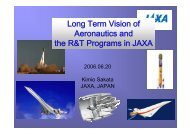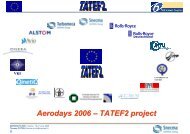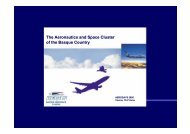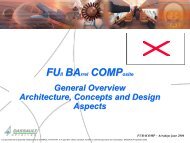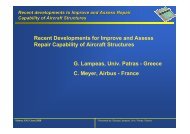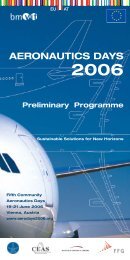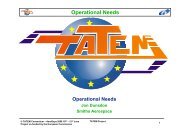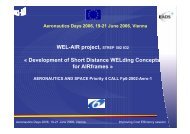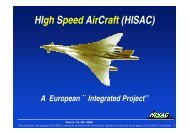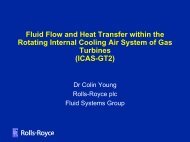ICE: Ideal Cabin Environment - Aeronautics Days 2006
ICE: Ideal Cabin Environment - Aeronautics Days 2006
ICE: Ideal Cabin Environment - Aeronautics Days 2006
Create successful ePaper yourself
Turn your PDF publications into a flip-book with our unique Google optimized e-Paper software.
<strong>ICE</strong>: <strong>Ideal</strong> <strong>Cabin</strong> <strong>Environment</strong>Dr David Ross(Presentation to <strong>Aeronautics</strong> <strong>Days</strong> – June <strong>2006</strong>)© BRE on behalf of <strong>ICE</strong> Consortium <strong>ICE</strong>
<strong>ICE</strong>: <strong>Ideal</strong> <strong>Cabin</strong> <strong>Environment</strong>(October 2005 – end September 2008)© BRE on behalf of <strong>ICE</strong> Consortium <strong>ICE</strong>
<strong>ICE</strong>To be the definitive study on aircraft cabinenvironments and passenger health© BRE on behalf of <strong>ICE</strong> Consortium <strong>ICE</strong>3
<strong>ICE</strong> Consortium• Aviation Health– AGAI (LT)– Avitronics (GR)– DLR (DE)– Univ of Vienna (AT)– Univ. College & RFH(GB)• <strong>Environment</strong>al technology– BRE (GB) – Co-ordinator– FhG (DE)– NLR (NL)– Univ of Oldenburg (DE)– Univ of Padova (IT)– Univ of Prague (CZ)• Airframer– Airbus (DE)– EADS – CRC (DE)• Regulations/Medical Chair– AHU – UK DfT/CAA(GB)© BRE on behalf of <strong>ICE</strong> Consortium <strong>ICE</strong>4
Why there is a need for <strong>ICE</strong>• Widespread concern about the impact of flying on the health,well-being, and comfort of passengers - increasing because of:– Changing passenger demographics– Advent of ultra long haul services– Specific issues issued with flying such as cabin pressure• Other studies provided major parts of the jigsaw – <strong>ICE</strong> isneeded to combine, integrate and provide closure• Project will address European SRA2 ‘Highly customer orientedair transport system’© BRE on behalf of <strong>ICE</strong> Consortium <strong>ICE</strong>5
Exciting developments© BRE on behalf of <strong>ICE</strong> Consortium <strong>ICE</strong>6
<strong>ICE</strong> has three main objectives• Establish combined effects of cabin environmentalparameters, including cabin pressure, on the health ofpassengers.• Produce predictive design models (PDM) based onvarying all relevant parameters including cabin pressure,to include synergistic, and other combined effects.• Provide a European pre-standard, and design guides andpractical recommendations for stakeholders.© BRE on behalf of <strong>ICE</strong> Consortium <strong>ICE</strong>7
<strong>ICE</strong> PDM© BRE on behalf of <strong>ICE</strong> Consortium <strong>ICE</strong>8
WP1: Knowledge integration• Transfer results from <strong>Cabin</strong>Air, HEACE & FACE• Stakeholder views – mid-term workshop, final Conference• Review impact of cabin environment on passengersSynthesis of up to date knowledgeIdentification of parameters that have greatest impact oncabin occupant health© BRE on behalf of <strong>ICE</strong> Consortium <strong>ICE</strong>9
WP2: Campaign design• Define target subject groups and flight conditions• Prepare pressurised flight test facility• Develop experimental design – environmental,physiological and psychologicalPassenger profilesUnique ground-based facility for aircraft cabinenvironmentsProtocols for identifying health impact resulting from cabinenvironmental parameters© BRE on behalf of <strong>ICE</strong> Consortium <strong>ICE</strong>10
WP3: Flight campaign – ACE, FTF and in-flight• Carry out structured studies of subjects in ACE and FTF• Monitor internal parameters, and record physiological andpsychological responses of passengers• Carry out in-flight validation – pre- and during testingInclusion of cabin pressure in a realistic environmentVariation of parameters to define optimum humanenvironmentSynergistic impact of cabin parameters© BRE on behalf of <strong>ICE</strong> Consortium <strong>ICE</strong>11
ACE & FTF© BRE on behalf of <strong>ICE</strong> Consortium <strong>ICE</strong>12
FTF – Flight Test Facility• Location– 30 km south of Munich (Germany)– Near the Bavarian Alps© BRE on behalf of <strong>ICE</strong> Consortium <strong>ICE</strong>13
FTF: 16. Jan <strong>2006</strong>© BRE on behalf of <strong>ICE</strong> Consortium <strong>ICE</strong>14
FTF: 16. Jan <strong>2006</strong>© BRE on behalf of <strong>ICE</strong> Consortium <strong>ICE</strong>15
FTF: Pressure Test© BRE on behalf of <strong>ICE</strong> Consortium <strong>ICE</strong>16
WP4: Building data engine• Create electronic database to handle and process verylarge data sets• Import data and automate verification• Identify parameters that impact significantly on health andwell-being of occupantsAutomated electronic databaseValidated datasets for generating human response modelsIdentification of dominant controlling parameters© BRE on behalf of <strong>ICE</strong> Consortium <strong>ICE</strong>17
WP5: Human impact and optimisation• Identify individual and combined effects of parameters onoccupant health• Develop parametric, and health-based models to quantifythis• Provide optimised envelope of cabin parameters foroccupant well-being Predictive design models for passenger health and wellbeingRecommended optimised levels for parameters – includingcabin pressure© BRE on behalf of <strong>ICE</strong> Consortium <strong>ICE</strong>18
WP6: <strong>ICE</strong> recommendations and standard• Develop technical and operational recommendations• Participate in Standards and Regulatory bodies –ECAC/APHI and ASD-STAN• Develop draft pre-StandardProvide guidelines for cabin environment design strategiesProvide recommendations for stakeholdersProvide draft European pre-Standard© BRE on behalf of <strong>ICE</strong> Consortium <strong>ICE</strong>19
<strong>ICE</strong> will meet these three main objectives!• Establish combined effects of cabin environmentalparameters, including cabin pressure, on the health ofpassengers.• Produce predictive design models (PDM) based onvarying all relevant parameters including cabin pressure,to include synergistic, and other combined effects.• Provide a European Pre-Standard, and design guides andpractical recommendations for stakeholders.© BRE on behalf of <strong>ICE</strong> Consortium <strong>ICE</strong>20
Contact detailsDr David RossBREGarston, WatfordHerts. WD25 9XXU.K.T: +44 (0) 1923 66 4505E: rossd@bre.co.uk© BRE on behalf of <strong>ICE</strong> Consortium <strong>ICE</strong>21




